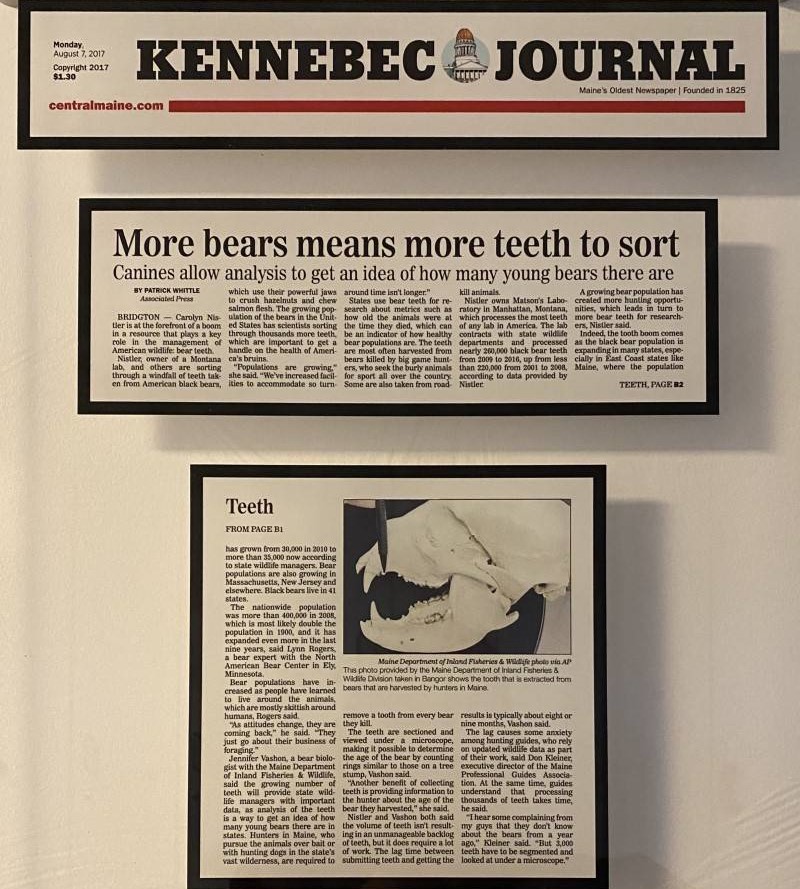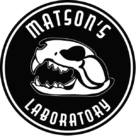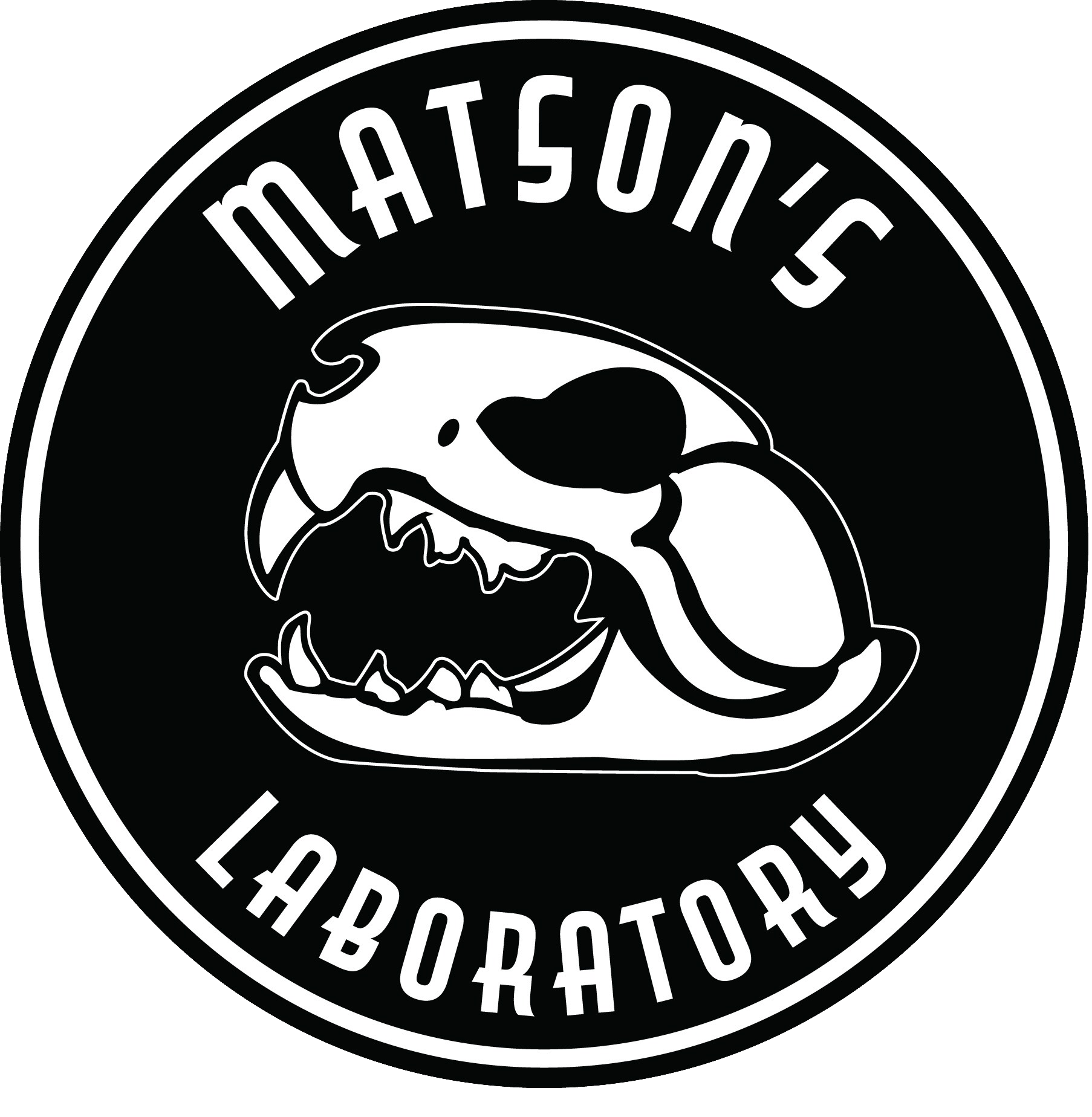News & Publications
Trusted by hunters and biologists worldwide, Matson’s Lab is the leader in cementum age analysis!
More Accurate.
More Precise.
More Experienced.
Matson’s Lab strives to provide accurate and precise results. We continuously work with hunters, agencies, biologists, and researchers to test and improve our aging models and methods. Over the years, we have tested our aging accuracy, precision, and experience using blind duplicates and known age animals. Trust the experts to age your deer and other game species!
Accuracy and Precision
Accuracy and precision are top priorities at Matson’s Lab. Our aging experts are required to undergo extensive species-specific training, evaluation, and maintain the highest standards of accuracy and precision before aging samples for clients. Additionally, throughout the years, various researchers have conducted studies to evaluate the accuracy and precision of the age estimates we provide using cementum age analysis. Check out the following articles to learn more!
Sex identification and age estimation of bobcats and implications for management
Hiller, T.L., C. Nistler, D. Reding, P.A. White and F. Bled. 2022. Sex identification and age estimation of bobcats and implications for management. Wildlife Society Bulletin e1328.
Hiller et al. (2022) assessed both the accuracy of furtaker-assigned sexes of bobcat by comparing them to genetically determined sexes and the precision of cementum annuli analysis age estimates from Matson’s Lab for bobcat canines and incisors. They determined that furtaker-assigned sexes were 82% accurate and canines were more precise for estimating ages than incisors.
Hiller et al. (2022) assessed the accuracy of furtaker-assigned sexes of bobcats and the precision of cementum annuli analysis age estimates for bobcat canines and incisors. Biological parameters including sex and age data are important for making informed management decisions for bobcats. The study objective was to provide quantifiable uncertainty levels for sex and age data that can be incorporated into large-scale bobcat population modeling efforts. They obtained 123 bobcat mandibles from the western United States of unknown age with furtaker-assigned sexes to conduct the study. DNA analysis was used to obtain genetically determined sexes for each bobcat, and age estimates were determined using cementum annuli analysis of paired canines and incisors at Matson’s Laboratory. Furtaker-assigned sexes were found to be 82% accurate when compared to genetically assigned sexes and mean estimated age for paired canines and incisors were 2.6 and 2.4 years old, respectively. The mean difference in estimated age for canines was 0.19 years compared to a mean difference of 0.88 years for incisors, which indicated that age estimates from canines were more precise than incisors. They concluded that age estimates were more precise for canines than incisors with precision decreasing with age and that male bobcat age estimates may be more precise than females. Wildlife managers can incorporate known errors associated with sex identification and age estimation into population models to help better manage bobcats and reach management objectives.
Precision of cementum annuli method for aging male white-tailed deer
Adams, D.M. and J.A. Blanchong. 2020. Precision of cementum annuli method for aging male white-tailed deer. PLoS ONE 15(5): e0233421.
Adams and Blanchong (2020) tested the precision of Iowa white-tailed deer age estimates provided by Matson’s Laboratory and found that 99% of the ages provided for 473 pairs of duplicate incisors were within +/- 1 year of each other.
Adams and Blanchong (2020) evaluated factors that influence the precision of cementum annuli count (Cementum Age Analysis, or CA) age estimates from Matson’s Laboratory and congruence of age estimates derived from CA and the tooth replacement-and-wear technique (TRW). Paired incisors (n=473) were sent independently from one another over multiple years to ensure Matson’s Lab was unaware they were aging two teeth from the same deer. Their results indicated that 99 percent of the ages agreed within +/- 1 year and only one percent differed by >1 year. They concluded that CA is a better method than TRW for aging deer older than 2 years old and that managers should only use TRW to categorize deer in two age classes (yearling and ≥2 years) due to its high subjectivity for aging deer older than two.
Accuracy of Moose Age Determinations from Canine and Incisor Cementum Annuli
Boertje, R.D., M.M. Ellis and K.A. Kellie. 2015. Accuracy of Moose Age Determinations from Canine and Incisor Cementum Annuli (PDF). Wildlife Society Bulletin 39 (2): 383-389.
Boerjte et al. (2015) found that Gary Matson was 95% accurate in aging moose canines and 94% accurate in aging moose first incisors(I1) to within one year of the known ages of 84 moose from Alaska using cementum age analysis.
Boerjte et al. (2015) tested Gary Matson’s (founder of Matson’s Laboratory) accuracy rate in estimating moose ages from canine and first incisor (I1) teeth by comparing his age estimates to 84 known-age moose >2 years old from Alaska. Gary aged 95 percent of the canines (n=76) and 94 percent of the first incisors (n=77) to within one year of the known ages. No significant difference was found in accuracy based on tooth type.
Evaluating precision of cementum annuli analysis for aging mule deer from southern California
Asmus, J.A. and F.W. Weckerly 2011. Evaluating precision of cementum annuli analysis for aging mule deer from southern California. Journal of Wildlife Management 75(5): 1194-1199.
Asmus and Weckerly (2011) found that Matson’s Laboratory aged 926 of 994 pairs of duplicate incisors from California mule deer to within one year of each other for an overall precision rate of 93%.
Asmus and Weckerly (2011) evaluated the precision of cementum annuli analysis age estimates for southern California mule deer by sending in 994 pairs of duplicate first incisors (I1) for Matson’s Laboratory to analyze. This was a true blind study as Matson’s Lab was unaware that they were aging two incisors for each animal. Results indicated that 686 (70%) of the pairs were aged exact and 308 (30%) differed in age with 78% of those differing by only one year. The overall precision error rate was 17%, and they concluded that knowing error rates for specific deer populations may aid wildlife managers in performing management actions that require exact age class information.
Evaluating the accuracy of ages obtained by two methods for Montana ungulates
Hamlin, K.L., D.F. Pac, C.A. Sime, R.M. DeSimone and G.L. Dusek. 2000. Evaluating the accuracy of ages obtained by two methods for Montana ungulates. Journal of Wildlife Management 64:441-449.
Hamlin et al. (2000) found that Matson’s Laboratory cementum analysis age estimates were 97.3% accurate for elk, 92.6% accurate for mule deer, and 85.1% accurate for white-tailed deer from Montana.
Hamlin et al. (2000) used samples of known age for elk, mule deer, and white-tailed deer to evaluate the accuracy of age estimates derived from cementum-annuli counts (cementum age analysis) at Matson’s Laboratory and the tooth eruption-wear technique. Cementum age analysis age estimates were 97.3, 92.6, and 85.1 percent accurate for elk, mule deer, and white-tailed deer, respectively, whereas the eruption-wear method yielded lower accuracies ranging from 16 to 50 percent for elk, 62.3 percent for mule deer, and 42.9 percent for white-tailed deer. They concluded that cementum age analysis is more reliable and accurate than the eruption-wear technique and is necessary to accurately estimate population age structures for elk, mule deer, and white-tailed deer in Montana.
Analysis of error from cementum-annuli age estimates of known-age Pennsylvania black bears
Harshyne, W.A., D.R. Diefenbach, G.A. Alt and G.M. Matson. 1998. Analysis of error from cementum-annuli age estimates of known-age Pennsylvania black bears. Journal of Wildlife Management 62:1281-1291.
Harshyne et al. (1998) found that Matson’s Laboratory cementum age estimates for 521 Pennsylvania black bears were 92% accurate with the remaining 8% aged within +/- 1 year.
Harshyne et al. (1998) tested the accuracy of the cementum-annuli count method (cementum age analysis) used by Matson’s Laboratory to age black bears by comparing Matson’s age estimates to known ages of 521 Pennsylvania black bears. Of the 521 known age bears, 92 percent were aged exact using cementum annuli counts with the remaining 8 percent aged within +/- 1 year of the known ages. Cementum-annuli counts provided highly accurate age estimates, and they concluded that the cementum annuli count technique is valid for aging Pennsylvania black bears.
Ready To Have Your Harvest Aged By The Experts?
News
Matson’s Laboratory has been featured in numerous news articles. Check out the following articles to learn more about the work we do at the lab!
Why does New Hampshire send hundreds of wild animal teeth to a Montana laboratory every year? (Concord Monitor, September 2019)
Want the Truth? Slice the Tooth (Bugle, May/June 2018)
Prime Tine (Bugle, May/June 2018)
More bears means more teeth to sort (Kennebec Journal, August 2017)
The proof is in the tooth: Aging deer (Outdoor News: The Sportsman’s Weekly, August 2017)
Growing bear population gives researchers more teeth to sort (Billings Gazette, 2017)
The proof is in the tooth: Manhattan new home to animal tooth lab (Bozeman Daily Chronicle, 2015)
Long in the tooth: Gary Matson leaves legacy of wildlife dental science (The Missoulian, 2015)

Other Publications
We take great pride in our role of providing age data to help biologists and researchers manage and conserve wildlife species worldwide. Check out the following articles to see how we are making an impact.
Comparison of two methods to age gray wolf teeth
Ballard, W.B., Matson, G.M. and P.R. Krausman. 1995. Comparison of two methods to age gray wolf teeth. Pages 455-459 in Carbyn, L.N., S.H. Fritts and D.R. Seip. Ecology and conservation of wolves in a changing world. Canadian Circumpolar Institute, Occasional Publication No. 35. 642 pp.
Ballard et al. (1995) compared the efficacy of two different stains that help make cementum annuli more visible for aging gray wolf canines and premolars: the Modified Hematoxylin (HMH) stain and Giemsa Stain (GS).
The HMH stain is more expensive than GS and has only been proven effective in staining cementum annuli in canine teeth which inhibits the ability to age live wolves. They found that premolars stained with HMH could not be aged accurately, but canines stained with HMH and premolars stained with GS provide similar age results. Their findings are significant because extracted premolar teeth from live wolves can now be used to accurately estimate ages providing researchers with an easier and more cost-effective way to obtain wolf age data.
Population trends for two Malagasy fruit bats
Brook, C.E., Ranaivoson, H.C., Andriafidison, D., Ralisata, M., Razafimanahaka, J., Heraud, J., Dobson, A.P. and C.J. Metcalf. 2019. Population trends for two Malagasy fruit bats (PDF). Biological Conservation 234: 165-171.
Brook et al. (2019) quantitatively assessed population trajectories for two species of Madagascar fruit bats that serve as crucial pollinators and seed dispersers. They live captured bats from 2013-2018 and extracted premolars from 288 bats which were aged at Matson’s Laboratory.
The age data enabled them to form adult survival rates and infer juvenile survival rates through matrix modeling. Their results suggested that population viability of these two species is in danger, and they concluded that immediate management and conservation actions were needed to protect Madagascar fruit bats.
Disentangling serology to elucidate henipa- and filovirus transmission in Madagascar fruit bats
Brook, C.E., Ranaivoson, H.C., Broder, C.C., Cunningham, A.A., Heraud, J., Peel, A.J., Gibson, L., Wood, J.L.N., Metcalf, C.J. and A.P. Dobson. 2019. Disentangling serology to elucidate henipa- and filovirus transmission in Madagascar fruit bats (PDF). Journal of Animal Ecology 88 (7): 1-16.
Since bats can be carriers for viruses emerging in human populations and are widely consumed as human food in Madagascar and other regions, Brook et al. (2019) studied Malagasy fruit bats to better understand prevalence, seasonal changes, and transmission of henipaviruses and filoviruses.
Age data provided by Matson’s Laboratory helped them gain information about viral characteristics among bat age ranges. Their findings provided valuable insight into the nature of these viruses that may help develop the framework for future public health protection initiatives.
Health and Mortality Monitoring in Threatened Mammals: A First Post Mortem Study of Otters (Lutra lutra L.) in Italy
Fusillo, R., M. Romanucci, M. Marcelli, M. Massimini and L.D. Salda. 2022. Health and Mortality Monitoring in Threatened Mammals: A First Post Mortem Study of Otters (Lutra lutra L.) in Italy. Animals 12(5): 609.
Fusillo et al. (2022) conducted a post mortem study of endangered Eurasian otters in Italy to assess their current conservation status. They collected extensive biological data from otter carcasses and obtained age data from Matson’s Laboratory to help identify factors contributing to mortality.
Fusillo et al. (2022) conducted a post mortem study of endangered Eurasian otters in Italy from 2009 to 2017 to assess their conservation status by identifying important factors contributing to population declines. In addition to extensive biological examination, individual otters were aged at Matson’s Lab using tooth cementum age analysis. They determined that vehicle collisions involving young individuals (≤ 2 years old) accounted for the majority of mortalities (71 percent) while blunt chest trauma, dog and conspecific attacks, and diseases accounted for the rest. They concluded that road-kill mitigation measures and coordinated research efforts with standardized post mortem analyses of otters are critical to direct future conservation strategies.
Longevity and Mortality of Boreal Woodland Caribou (Rangifer tarandus caribou) of the Dehcho Region, Northwest Territories
Larter, N.C. and D.G. Allaire. 2016. Longevity and Mortality of Boreal Woodland Caribou (Rangifer tarandus caribou) of the Dehcho Region, Northwest Territories (PDF). Canadian Field-Naturalist 130 (3): 222-223.
Larter and Allaire (2016) investigated the death sites of 25 radio-collared Woodland caribou that are part of a long-term caribou ecology study in the Dehcho region of the Norwest Territories in Canada. They collected tooth samples from the carcasses and sent them to Matson’s Laboratory to age using cementum age analysis, where over 42,000 caribou teeth have already been aged.
The seven oldest caribou ranged from 13 to 22 years old with all but one giving birth to a calf during the time they were collared and monitored. These findings suggest that caribou have high pregnancy rates throughout their lifespan which could increase population resilience to disturbance and change.
Cementum annuli are unreliable reproductive indicators in female brown bears
Matson, G.M., Casquilho-Gray, H.E., Paynich, J.D., Barnes Jr., V.G., Reynolds, H.V. and J.E. Swenson. 1998. Cementum annuli are unreliable reproductive indicators in female brown bears. Ursus 11: 275-280.
Matson et. al (1998) tested the hypothesis that the same method of examining tooth cementum annuli patterns to accurately reconstruct black bear reproductive histories would also be effective for brown bears.
They used teeth from 29 brown bears of known reproductive histories to estimate cub-rearing years based on cementum thickness and were only able to accurately estimate 13 of the 62 known years of cub-rearing. Based on these results, they concluded that cementum layer patterns are not a reliable way to reconstruct brown reproductive history.


